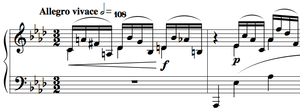Prelude in A-flat major (Rachmaninoff)

The Prelude in A-flat major, Op. 23, No. 8, is a 1903 composition by Sergei Rachmaninoff.[1][2] It is part of Rachmaninoff's Ten Preludes, Op. 23.
Structure
The work is three-part ternary; however, it assumes monothematic characteristics. The first occurrence Section A comprises measures 1-19, Section B of 19-43, Section A returns from measures 43-70, and the coda is placed at measures 70-78.
A right hand figuration extends over a descending quarter-note melody in the first two bars, outlining the A flat chord. This motive repeats, and then is varied in measures 5-8, in succession. From measures 9-18, the section is restated though a transient modulation to E major (at measure 15). An imperfect cadence in the tonic bridges the transitory gap in measure 18 to the B section in E flat.
Measures 19-20 introduce a variant of the main motive. Now in a new key, the bass melody changes, descending chromatically in an eighth-note figure.

Measure 19
A transition section comes together though the combination of ascending and descending chromatic scale fragments at measures 31-41. Vertiginous modulations swing through E flat - G - C - F - A flat and B flat, before settling into E flat at measures 39-41.

Measures 31 and 32
The original statement occurs beginning at measure 42, and then a progression at measures 54-62 through F- B flat - D flat and F minor provides a link to measures 61-70, where the harmonies become vague and undistinguishable:

Measures 61 and 62
The coda exhibits a gradual breakdown of the forward motion, and, with a quarter-note progression in the final three bars, the A flat tonality is reestablished.

Measures 76-78
Analysis
Some critics of this Prelude, such as John Culshaw, believe that the relentless, florid nature of the sixteenth-note figures extinguishes any expressive quality of the work.